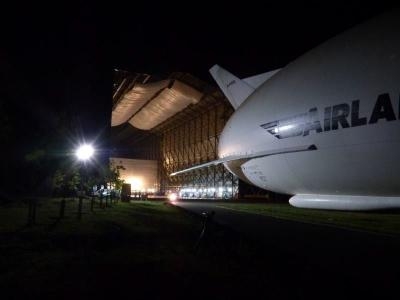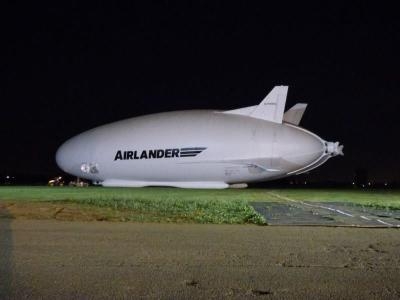World's Largest Aircraft Publicly Visible For The First Time
Following the completion of all indoor testing, the Airlander 10, the world’s largest aircraft, has successfully exited the hangar for the first time late last month.

Technical Director, Mike Durham stated, “We successfully completed our final in-hangar all engines, all generators, all systems testing. My thanks to the whole business for getting us here. The entire team is looking forward to the final series of tests outside before taking to the skies for the first time.”
Being the largest aircraft in the world, exiting the hangar was a very delicate operation as there was only a 6m clearance from the fin tip to the sides of the hangar doors. It took around 5 minutes for the Airlander to clear the hangar and then a further 30 minutes for her be towed to rest at the primary mast site - one of the two that have been specially prepared for her on the airfield.
The exit only commenced when Alex Travell, HAV’s Ground Operations Chief, was given clearance to proceed by both Chief Test Pilot David Burns and Technical Director Mike Durham. All three of them had to be happy that a large number of safety, equipment and weather requirements were ticked off on the hangar exit checklist. The total team involved in exiting the hangar comprised of less than ten personnel, but was watched by 50 employees who gathered outside this airfield in the middle of the night to watch this unique occasion.
"It was a very smooth first journey for Airlander and she behaved beautifully. We're delighted to have reached this significant milestone," says Technical Director Mike Durham.

Now it is at its masting site, the aircraft is free to ‘weathervane’ nose into wind as a result of being attached to the Towable Moving Mast (TMM) and resting on the Castering Ground Cradle (CGC), which supports the fuel tank and has its own set of wheels. To minimise wear and environmental impact during this time, the landing skids have been fitted with special ‘shoes’. A short time later and Airlander will be ready to take to the skies.
The Airlander will be able to withstand wind speeds of up to 85 knots whilst on the mast, making her very resilient to most weather systems that pass through. While on the mast, there will be a strong 24hr security presence as well as staff constantly monitoring the status of the Airlander.
While the Airlander is out on the mast, the last few tests (including full power engine runs, electromagnetic interference checks and a final overall vehicle systems checkout) will be conducted. At the end of these tests the team will assess the need for either a brief return to the hangar for final inspections or, subject to weather, those inspections may be carried out on the mast.
Then it will be time for pilots David Burns and Simon Davies to take command of the Airlander 10, christened the Martha Gwyn in April, and start the flight test program of this unique and game-changing aircraft. The company says it will announce the date of first flight in due course.
(Images provided with Airlander news release)
 ANN's Daily Aero-Linx (05.02.24)
ANN's Daily Aero-Linx (05.02.24) ANN's Daily Aero-Term (05.02.24): Touchdown Zone Lighting
ANN's Daily Aero-Term (05.02.24): Touchdown Zone Lighting Aero-News: Quote of the Day (05.02.24)
Aero-News: Quote of the Day (05.02.24) ANN FAQ: Contributing To Aero-TV
ANN FAQ: Contributing To Aero-TV NTSB Final Report: Cirrus Design Corp SR20
NTSB Final Report: Cirrus Design Corp SR20




